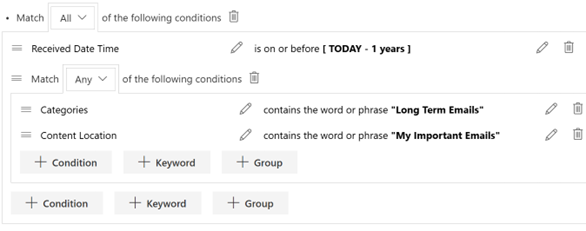 Image courtesy of Anna Shvets from Pexels
Image courtesy of Anna Shvets from Pexels
There’s an Excel formula that’s burned into my brain forever, and it goes like this: IF(ISERROR(MATCH(A1, B:B, 0)),”no match”, A1).
My Past Pains Managing Physical Records
When I worked as a records manager, this one formula was the only way I could identify which of our thousands of physical items were ineligible for destruction. I ran it hundreds of times, on a spreadsheet that was nearly a million rows long and almost half a gigabyte in size. The operation required detailed change logs, dozens of versions, detailed tabs, and even a numeric key assigned to each item, so that I could identify which records had reached the end of their retention period and which were permanent and could never be destroyed. I had to reach out to multiple departments to wrangle the metadata I needed to ensure that close dates were accurate. I also had to reconcile the fact that several box barcodes were duplicated or overlapped with one another.
There was no existing infrastructure to flag the super important permanent retention items as such; the only way I could flag the crucial corporate minute books was to keyword search the spreadsheet, and minute books could be listed under things like “MB”, “mnbk”, “min bk”, “min book.” Or—my personal favorite—absolutely nothing at all. And through it all, the formula endured: IF, ISERROR, MATCH, “no match.”
In hindsight, it really wasn’t surprising that a few hundred boxes of permanent retention items hit the shredder. I caught my mistake early and was able to prevent any genuine damage, and over the next year I repeated the entire process about half a dozen more times in an ultimately futile attempt to successfully destroy a few thousand boxes of paper. Each time, I swore that I’d finally do it right and catch all the possible edge cases before sending the list off to the vendor. But each time, I would inevitably discover yet another issue I’d failed to account for.
| "Unfortunately, nearly every records manager has a physical records management horror story..." |
My Story is Not Unique
Unfortunately, nearly every records manager has a physical records management horror story like mine: a tale of legacy records, siloed databases, haphazardly cobbled-together repositories, mismatched metadata columns, wildly inaccurate Excel spreadsheets... and the ways it can all go horribly wrong. Every time a discovery session turns to the subject of physical records management, I hear about these pain points and know the feeling all too well. So it’s always a pleasure to be able to demonstrate how Collabspace’s physical records feature works, not only because I’m an employee, but also because I know, viscerally, how amazing it is to have a system that addresses so many of those pain points.
While almost every organization has both physical and electronic records to manage, it is rare for them to be controlled in the same place. Physical and digital records have very different demands; concepts like “destruction” will have wildly different outcomes depending on whether you’re shredding paper or digitally erasing Word documents. While there’s more than enough overlap, most organizations still end up splitting their records management between several systems.
Addressing the Pain Points with Collabspace
Collabspace’s physical records feature set offers so many of the things I often wished for as a records manager. It carves out a space for the physical alongside the electronic, allowing them to optimize the crucial overlap in content and retention while also meeting the respective needs of entirely different mediums. Instead of keyword searching for the term “will” in thousands upon thousands of spreadsheet rows, users can build an advanced search query to locate only the items they need. Custom templates allow for the creation of fields like “Permanent Item Status” or “Alternate Barcode”, and the bulk upload feature means that thousands of modifications can be done in just a small handful of clicks.
If I’d had Collabspace Physical back at my old job, I would have been able to export the metadata of the records I needed, without having to bug the IT department for back-end database access. I would have had the close dates of files integrated into the content template, so that I didn’t have to play email tag with the accountants. I would have been able to construct an advanced search query to exclude the items I knew I didn’t need, and would also been able to search multiple metadata fields simultaneously instead of painstakingly combing through the raw data.
The subsequent exports would have been smaller, more manageable spreadsheets, and when I ran my fateful formula—IF, ISERROR, MATCH, “no match”—I would have been able to tag permanent items in Collabspace with a bulk update, using just one CSV to apply changes to thousands of records at a time. I would have been able to classify physical records to the same record categories as their electronic counterparts, and run them through automated workflows so that they couldn’t be destroyed prematurely.
Conclusion
Records management is often a matter of creative thinking, abstraction, and problem solving. It’s crucial to be able to grasp the scope of the data you’re working with, and to be able to manipulate it and make decisions with confidence, knowing that the organization’s success can ride on having the right records in the right place at the right time. Collabspace’s physical records feature provides so much support and empowerment for users to be able to make those decisions, and to ensure they’re never left at the mercy of the Excel gods again.
Are you dealing with your own spreadsheet nightmares when managing physical records? I delivered a webinar session showcasing tangible, everyday examples of how I eliminated physical records frustrations with Collabspace. You can access the webinar recording here:
If you would like to learn more about how your organization can streamline your physical records management, please contact us. You can read the Collabware blog for more details on Collabspace physical records features, RM best practices and more!





